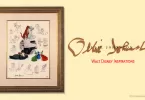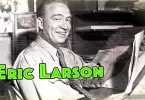When Walt Disney had to replace his Oswald the Rabbit cartoon character because he no longer owned the intellectual property rights to it, he and his friend and business associate, Ub Iwerks, decided on another anthropomorphized animal. A mouse. A mouse that would become very famous, indeed. In fact, this particular mouse’s image is still associated with anything to do with the Walt Disney Company today and is instantly recognized around the world. That mouse’s name? Mickey Mouse.
While the origins of Mickey Mouse are not clear, Disney himself intimated that Mickey may have been inspired, at least in part, by a pet mouse Walt owned when he had his original Laugh-O-Gram cartoon studio (the predecessor to Walt Disney Studios). When developing their new cartoon mouse mascot, Walt wanted to name him Mortimer Mouse. However, Walt’s wife Lillian vetoed that, in one of her few interferences in her husband’s business. She thought the name Mortimer was too pompous-sounding and suggested the name Mickey instead. Lillian chose wisely. The name became legendary and iconic.
Walt made some preliminary sketches of what Mickey Mouse would look like, which were quickly revised by Ub Iwerks to make the mouse easier to animate. At this point in the business, Walt had begun distancing himself from the actual process of animation, letting his in-house artists do that for him. He did, however, provide Mickey Mouse’s voice until 1947. Disney employees who were around at the time Mickey Mouse was created later said that Ub gave Mickey Mouse his iconic physical appearance, but with his voice work, Walt gave Mickey his soul.
Mickey Mouse made his introduction to the world in a May 1928 test screening for a cartoon short called Plane Crazy. This cartoon was followed up with The Gallopin’ Gaucho. Both of these short cartoons were unable to find a distributor. Inspired by the synchronized sound used in the 1927 hit movie The Jazz Singer, Walt incorporated the technique into the third Mickey Mouse short cartoon, Steamboat Willie—and, in the process, created the first-ever post-produced sound cartoon.
Once animation on Steamboat Willie was complete, Walt was able to sign a contract with Pat Powers, the former executive of Universal Pictures. The contract was to allow Walt’s company to use Powers’s Cinephone recording gear used at the studio. As a result, Cinephone became Walt’s new distributor, working solely with his new, innovative sound cartoons. These sound cartoons soon became immensely popular among the movie-going public.
Walt began to concentrate on improving the sound quality of the music in his cartoons. To this end, he hired Carl Stalling, a professional composer and music arranger. Carl’s suggestion inspired Walt’s Silly Symphony cartoon series, which told stories through the use of music. The first cartoon in this series was The Skeleton Dance, released in 1929. This cartoon was drawn and animated by Ub Iwerks alone.
As Walt had lost all of his in-house artists except Ub to a competitor just prior to the development of Mickey Mouse, he used the success of the Silly Symphony series to hire new in-house artists. Many of these new hires stayed with the company for decades and became the Walt Disney Company’s original group of core animators. They later referred to themselves as the Nine Old Men.
Mickey Mouse and the Silly Symphony cartoon series were both a success. However, Walt and his brother Roy (his primary business partner at the time) believed they were not receiving a fair share of profits from Pat Powers. So, in 1930, Walt attempted to reduce the costs of producing his cartoons by encouraging Ub to stop animating each separate cell of a cartoon. Instead, Walt wanted Ub to draw the key poses of a cartoon, and let lower-paid artists fill in the “in-between” poses.
After making these changes, Walt asked Pat for an increase in pay. Like the Oswald debacle with a different distributor, the request was refused, and Walt lost artists who Pat signed to him personally, including the previously loyal Ub. Other artists quit after Ub left, believing the Disney Brothers Studio would close without Ub to do the drawing. Walt himself had a nervous breakdown over all of this in 1931 and blamed Pat and his machinations on it, as well as his own tendency to overwork himself at his animation business. To help Walt heal, he and Lillian took a long vacation together to Cuba and Panama. Walt came back healed and better than ever in his outlook on things, especially his animation business.
Walt was once again without a distributor for his cartoons, so he signed with Columbia Pictures as the exclusive distributor of the Mickey Mouse cartoons. Cartoons featuring Mickey Mouse were becoming more and more popular with audiences, not only in the United States but around the world. After signing with Columbia, Walt became interested in using the new color technology for his cartoons, and all future Silly Symphony cartoons were produced in color. He filmed a cartoon short called Flowers and Trees in 1932, using three-strip Technicolor, and negotiated a deal that gave him the sole right to use the three-strip color process until 1935.
Flowers and Trees was so popular with audiences that it won Walt the Academy Award for Best Short Subject (Cartoon) at the 1932 Academy Awards presentation. That same year, and for that same awards ceremony and in that same category, Walt was also nominated for another of his cartoon shorts, Mickey’s Orphans. In addition to the Academy Award, he won that year, the Academy also presented him with an honorary award for creating Mickey Mouse. Today, Mickey Mouse is the official mascot for the Walt Disney Company, and all of its parks. Mickey Mouse ear hats are sold in Disney parks so guests can distinguish themselves as Disney fans. Though the Walt Disney Company has branched out far beyond cartoons in the modern era, the entire image of the company still comes back to Mickey Mouse.






